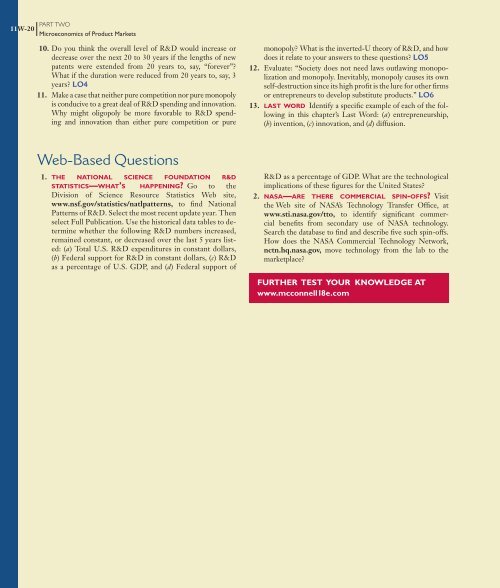Technology, R&D, and Efficiency - McGraw-Hill Higher Education
Technology, R&D, and Efficiency - McGraw-Hill Higher Education
Technology, R&D, and Efficiency - McGraw-Hill Higher Education
You also want an ePaper? Increase the reach of your titles
YUMPU automatically turns print PDFs into web optimized ePapers that Google loves.
11W-20<br />
PART TWO<br />
Microeconomics of Product Markets<br />
10. Do you think the overall level of R&D would increase or<br />
decrease over the next 20 to 30 years if the lengths of new<br />
patents were extended from 20 years to, say, “forever”<br />
What if the duration were reduced from 20 years to, say, 3<br />
years LO4<br />
11. Make a case that neither pure competition nor pure monopoly<br />
is conducive to a great deal of R&D spending <strong>and</strong> innovation.<br />
Why might oligopoly be more favorable to R&D spending<br />
<strong>and</strong> innovation than either pure competition or pure<br />
monopoly What is the inverted-U theory of R&D, <strong>and</strong> how<br />
does it relate to your answers to these questions LO5<br />
12. Evaluate: “Society does not need laws outlawing monopolization<br />
<strong>and</strong> monopoly. Inevitably, monopoly causes its own<br />
self-destruction since its high profit is the lure for other firms<br />
or entrepreneurs to develop substitute products.” LO6<br />
13. LAST WORD Identify a specific example of each of the following<br />
in this chapter’s Last Word: (a) entrepreneurship,<br />
(b) invention, (c) innovation, <strong>and</strong> (d) diffusion.<br />
Web-Based Questions<br />
1. THE NATIONAL SCIENCE FOUNDATION R&D<br />
STATISTICS—WHAT’S HAPPENING Go to the<br />
Division of Science Resource Statistics Web site,<br />
www.nsf.gov/statistics/natlpatterns , to find National<br />
Patterns of R&D. Select the most recent update year. Then<br />
select Full Publication. Use the historical data tables to determine<br />
whether the following R&D numbers increased,<br />
remained constant, or decreased over the last 5 years listed:<br />
( a ) Total U.S. R&D expenditures in constant dollars,<br />
( b ) Federal support for R&D in constant dollars, ( c ) R&D<br />
as a percentage of U.S. GDP, <strong>and</strong> ( d ) Federal support of<br />
R&D as a percentage of GDP. What are the technological<br />
implications of these figures for the United States<br />
2. NASA—ARE THERE COMMERCIAL SPIN-OFFS Visit<br />
the Web site of NASA’s <strong>Technology</strong> Transfer Office, at<br />
www.sti.nasa.gov/tto , to identify significant commercial<br />
benefits from secondary use of NASA technology.<br />
Search the database to find <strong>and</strong> describe five such spin-offs.<br />
How does the NASA Commercial <strong>Technology</strong> Network,<br />
nctn.hq.nasa.gov, move technology from the lab to the<br />
marketplace<br />
FURTHER TEST YOUR KNOWLEDGE AT<br />
www.mcconnell18e.com

















